
 |
|
|
|
|
|
|
||
|
Bioturbation in Black Shales |
||
| Although black shales are often thought of as environments too forbidding for metazoan life, many black shales are nonetheless bioturbated. Polychaete worms have adapted to quite low ambient oxygen concentrations, and are in many cases involved in black shale bioturbation. When oxygen is low they tend to live mainly in the very watery/soupy surface sediment (water contents 70-80%), and swim through the sediment rather than engaging in building of actual tunnels. Sediment "swimming" produces unique traces that are shown in the image set directly below. | ||
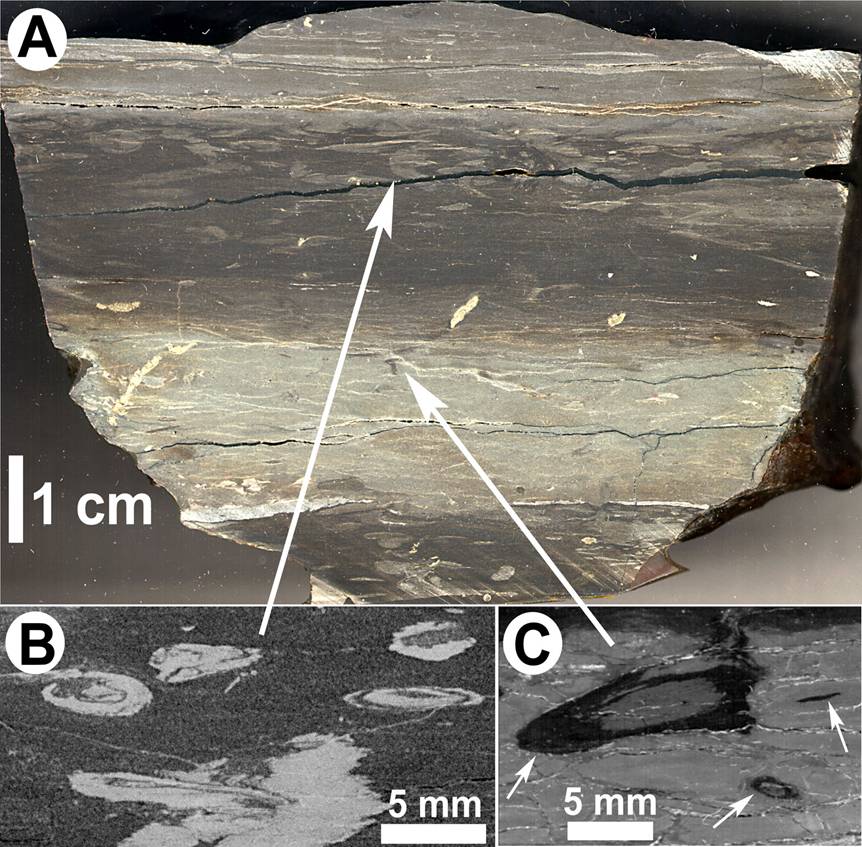 |
(A) Cut and ground (1000
grit) surface of shale that consists of alternating black
and greenish gray beds. Note the downward diminishing
abundance of gray burrow fills in the central black bed.
(B) Close-up of “mantle and swirl” traces in the upper portion of the black bed. These traces are produced when worms move/swim through the soft watery substrate (~70% water content) and drag gray mud downwards into black muds. (C) Close-up of equivalent traces (white arrows) that were produced when worms moved into the underlying gray layer and dragged black mud behind them. |
|
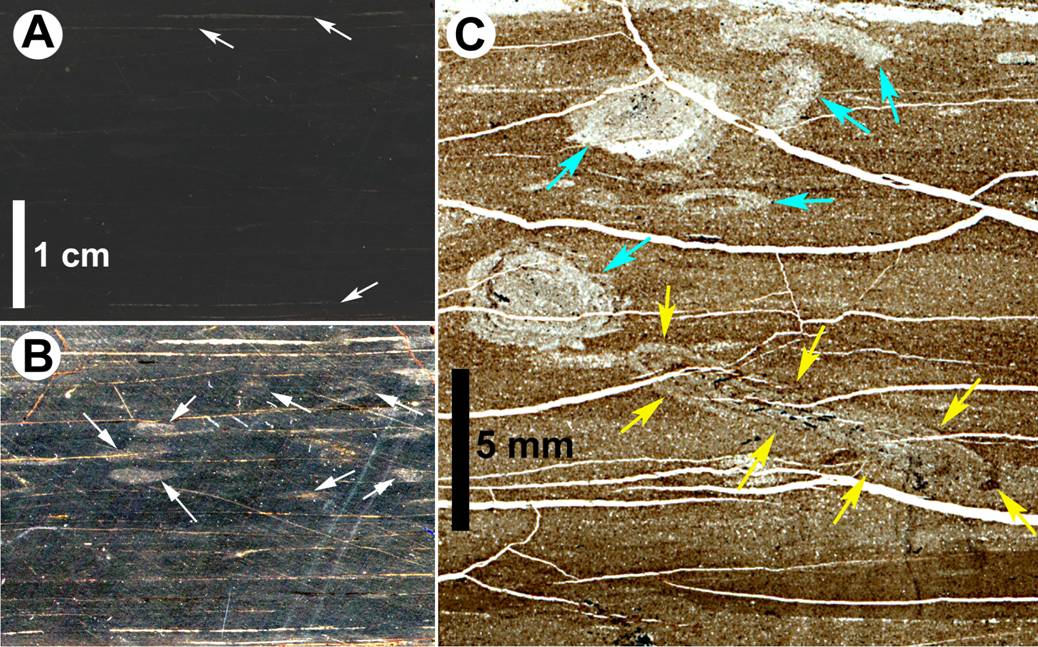 |
||
|
(A) Seemingly undisturbed black mud with
some silt laminae (white arrows). (B) the same image with serious image enhancement applied (contrast enhancement with PhotoshopTM). We see several lighter colored oval shaped features (white arrows) that turn out to be compressed “mantle and swirl” traces. Under normal conditions they are “invisible” because they are filled with black mud. (C) Thin section photomicrograph to illustrate the subtle nature of black shale filled traces. The blue arrows point out gray shale filled traces that can easily be observed on ground surfaces (Fig. 1), the yellow arrows outline a black shale filled trace that has little color contrast to the surrounding black shale. These traces are mainly recorded as fabric disruptions. |
||
|
Reference for above: Lobza, V., and Schieber, J., 1999, Biogenic sedimentary structures produced by worms in soupy, soft muds: Observations from the Chattanooga Shale (Upper Devonian) and experiments. Journal of Sedimentary Research, v. 69, p. 1041-1049. download PDF file (left click on link and click on "Save as"...) |
||
| Even more subtle evidence of bioturbation is seen in the following image set. In absence of lithologic contrast (gray-black) that allows sediment swimmer traces to be preserved, precipitation of diagenetic minerals can also preserve the activities of burrowing worms. The pyritic traces below may have formed when iron oxides formed initially along the walls of thin aerated burrows. Upon further burial these initial iron oxides were replaced by pyrite because of overall reducing pore waters. X-radiography reveals these traces in an otherwise solidly black shale. | ||
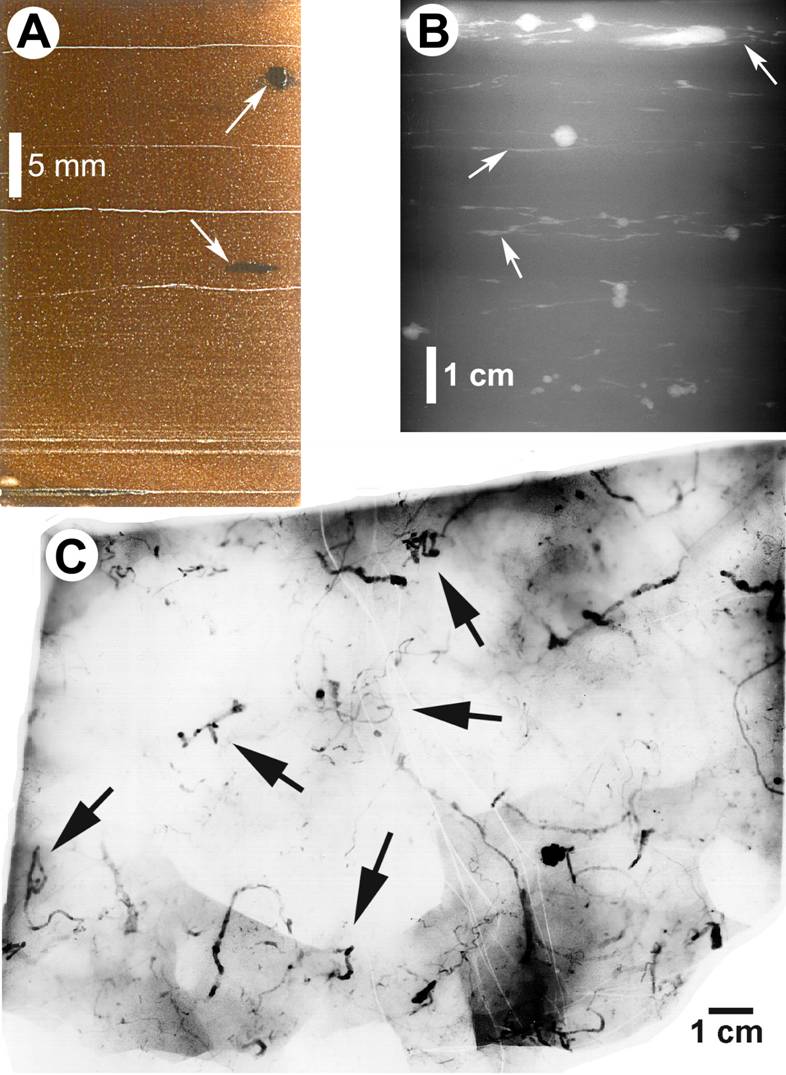 |
(A) Thin section of faintly
laminated black shale with mm-scale round-elliptical pyrite
concretions (arrows). Sample is from New Albany Shale in
Indiana.
(B) X-radiograph from same sample (note change in scale, view perpendicular to bedding). The laminae do not have enough contrast to show up, only pyritic structures produce sufficient contrast. We see irregular pyritic trails that move obliquely through the sediment (examples pointed out by arrows). The bright spots are localized pyrite accumulations that nucleated on these trails. (C) X-radiograph from a slab of comparable lithology in Chattanooga Shale of Tennessee (view perpendicular to bedding). We see pyritic trails with erratic and sharp turns. Intensity varies because pyritization is not uniform along trail. |
|
| In many cases it has been assumed that finely laminated black shales are indicative of the absence of bioturbation (otherwise, how could the fine laminae be preserved?). Yet, careful study of Devonian black shales demonstrates that, ironically, bioturbation may actually impart a secondary lamination on a previously largely homogenous black shale. The following two image panels serve to illustrate this concept. | ||
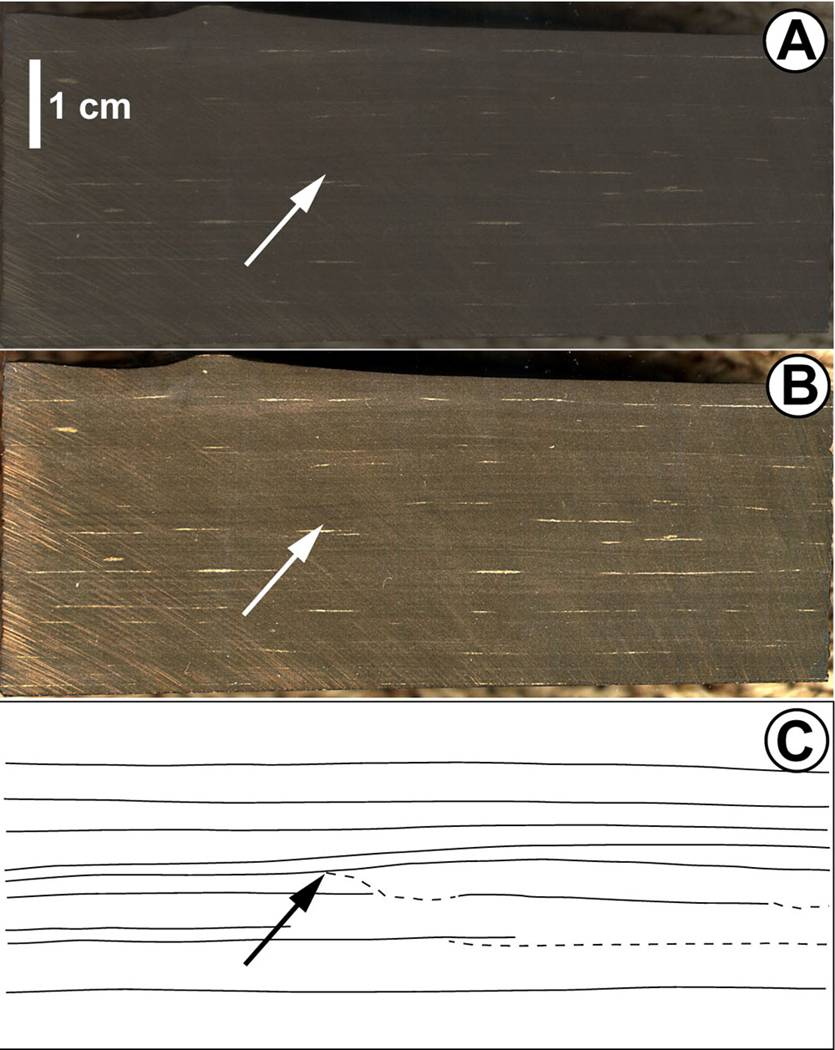 |
Laminated black shale from the New Albany
Shale of Indiana. (A) Black shale sample as it would
appear to the unaided eye.
(B) After contrast enhancement with PhotoshopTM. The see silty streaks are more clearly visible now, and we note that laminae are non-parallel, undulose, and terminated in places. (C) Tracing of some laminae to highlight lamina characteristics. Black arrow point to a spot where one lamina (from right) terminates against an overlying lamina. Lamina directly to the left has been cut by whatever produced the lamina coming from the right. The black arrow is reproduced in the same position in (A) and (B). |
|
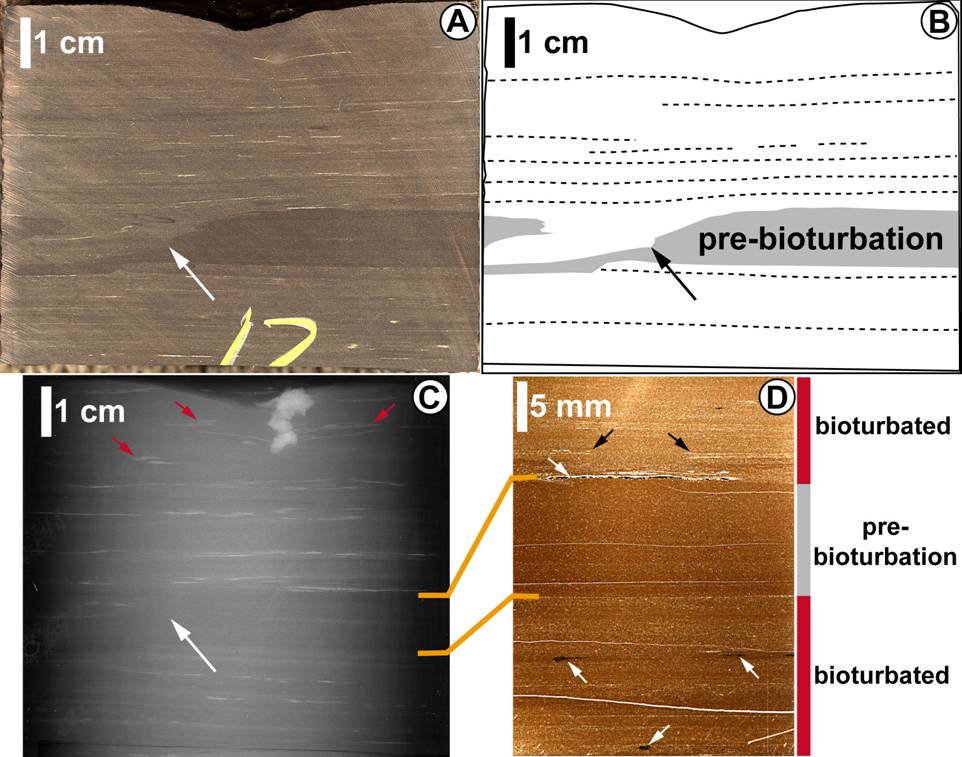 |
Same lithology as in previous Figure
(above). Image contrast enhanced with PhotoshopTM.
(A) The black shale with silty streaks clearly cuts
across (white arrow) an earlier black shale that appears
more homogenous and darker.
(B) Line drawing to highlight lamina characteristics and cross-cutting relationship in (A). The penetration is “burrow style” (black arrow). (C) X-radiograph of same sample. The arrows in (A), (B), and (C) all point to the cross-cutting bioturbation. |
|
|
For above image: (D)
Photomicrograph of thin section from same interval (note
scale change). It shows that the pre-bioturbation black
shale is indeed quite homogeneous, and that silty laminae
and streaks are typical for the bioturbated portions. More
abundant pyrite in silty streaks (white arrows) makes them
show up better in X-radiographs (C). We also see lamina
disruptions in the bioturbated portions (black arrows).
|
||
| Bioturbation can also help to highlight erosive events that otherwise would go un-noticed. It does so by introducing heterogeneity that is enhanced during erosive events and leads to irregular surface topograpy (allows easier visual detection of erosion surface), and by preserving sediments (at depth) that once formed entire layers that were later on completely removed by erosion. Both of these qualities are shown in the image set below. | ||
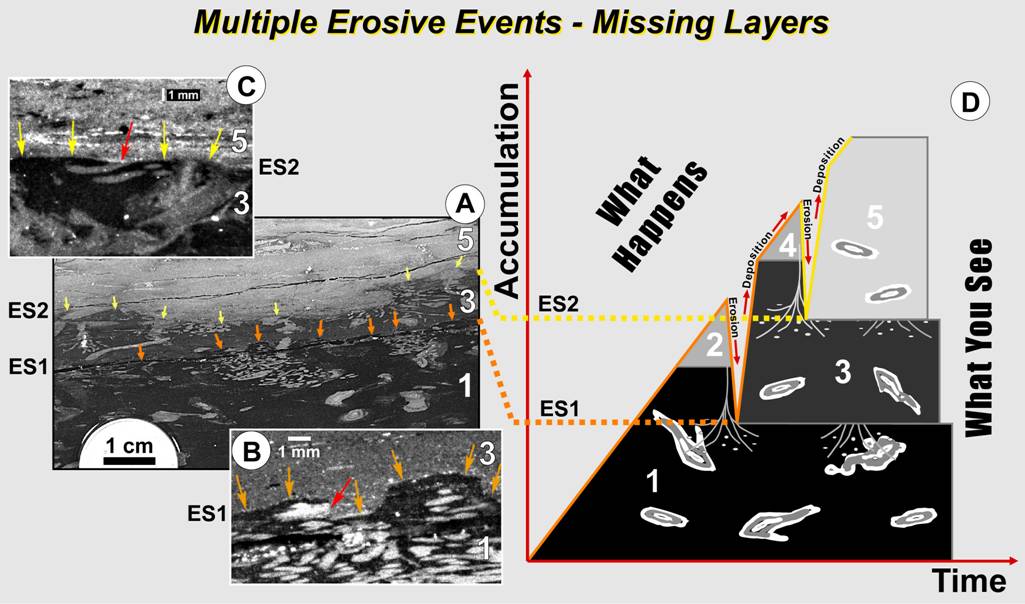 |
||
|
Multiple erosion and missing layers in a
black shale (layers numbered 1 through 5 in ascending
order).
(A) Strongly contrast enhanced image of black-gray shale couplet. We see that there are actually two dark layers. The lower one is truncated by erosion surface ES1 (orange arrows). The second dark layer is truncated by erosion surface ES2 (yellow arrows). (B) shows detail of ES1 (orange arrows) with irregular surface topography. The fill of the burrows in layer 1 is lighter in color than the material from the layers that covers the erosion surface (red arrow), indicating that the gray layer (layer 2) that supplied the fill has been eroded. (C) shows detail of ES2 (yellow arrows), and illustrates that the fill in the burrows of the second dark layer (layer 3) differs compositionally from the material of the overlaying gray layer (red arrow). (D) Sediment accumulation vs time diagram that illustrates the succession of events that lead to the observed rock record. |
||
|
Reference for above: Schieber, J., 2003, Simple gifts and hidden treasures – Implications of finding bioturbation and erosion surfaces in black shales. The Sedimentary Record, v. 1, p. 4-8. download PDF file (left click on link and click on "Save as"...) |
||
|
|
||
| Back to SHALE RESEARCH LAB Main Page | ||
| Back to IU Department of Geological Sciences | ||
|
||